![]() 1st Battalion 22nd Infantry
1st Battalion 22nd Infantry ![]()
Regimental History of the 22nd Infantry in the Philippines
Introduction
Map of the Philippine Islands The 22nd Infantry saw service
on the islands of Period map courtesy of the Fort Benning collection |
Campaign streamers of
Philippine Service Medal
Philippine Congressional Medal |
In 1898 America's war with Spain found US
forces engaged in battle in Cuba and the Philippine Islands.
The first battle between American and Spanish forces was in the
Philippines at Manila Bay where, on May 1, 1898,
Commodore George Dewey, commanding the United States Navy's
Asiatic Squadron aboard USS Olympia,
in a matter of hours defeated a Spanish squadron under Admiral
Patricio Montojo. By July of that year,
American troops were being landed near Manila and the occupation
of those Islands by the US began.
Revolution against Spanish rule in the
Philippines had been going on for several years, largely started
and carried out
by the Katipunan, a secret society formed to resist the Spanish
authorities. After much infighting among various factions,
the leader of that revolution emerged in the personality of
Emilio Aguinaldo, who led an armed uprising, which, in 1896,
resulted in an armistice between the opposing forces. The Spanish
granted the Filipinos certain liberties, in return for which
Aguinaldo consented to leave the Islands, for exile in Hong Kong.
Emilio Aguinaldo y Famy President and Commanding
General Aguinaldo resisted the US
occupation and control Several of his generals
continued the war |
|
In April of 1898, at around the same time the
US declared war on Spain, an American diplomat in Singapore, E.
Spencer Pratt,
conceived a plan to return Aguinaldo to the Philippines. Without
authorization from the US government, Pratt
promised Aguinaldo that if he returned to the Islands and resumed
his war of rebellion against the Spanish,
that a victorious United States would grant independence to the
Philippines. In May of 1898 Aguinaldo was conveyed by the US Navy
back to the main Island of Luzon, where he quickly assembled an
army and gained support of the population in victories against
the Spanish.
Aguinaldo declared the establishment of the First Philippine
Republic, and moved swiftly to replace Spanish authority
with an independent government, the first republic in the history
of Asia.
However, US foreign policy became ruled by the
desire to make the Philippines an American possession, and, as
Aguinaldo
prepared to attack Manila, US troops landed in the area, and
began the build-up of forces necessary to defeat the Spanish.
With the end of the war in sight, it became apparent the US was
not going to grant independence to the Philippines, and the
ever-increasing flow of American Soldiers to the Islands forced
Aguinaldo to move his headquarters to Malolos, some twenty-five
miles north of Manila. After the Treaty of Paris officially
concluded the war in December of 1898, the US
"purchased" the
Philippine Islands from Spain. A little over a month later, on
February 4, 1899, hostilities erupted at Manila between the
forces
of Aguinaldo and the US troops posted around the captial city.
Thus began a war between the United States and
the First Philippine Republic, which lasted officially from 1899
to 1902,
and, at the conclusion of which, another war started between US
forces and the Moros, the Muslim segment of population
throughout the southern Islands. Altogether America became
embroiled in a war in the Philippines which would last from 1898
until about 1913.
It turned into a brutal conflict, with
atrocities committed by both sides. Although the war between
Spain and the US had been
carried on in more of a "civilized" fashion, the war
against the Filipinos quickly dengerated into an ugly, no rules
barred
type of deadly contest, with each side trying to outdo the other
in the ways in which they could strike against their enemies.
Until the US involvement in Vietnam, some sixty
years later, the Philippine Insurrection was the most unpopular
war in American history.
America was divided into pro-expansion and anti-imperialist
camps, with the adherents of each dramatically vocal in their
opposition.
In recent times the war, especially the first phase carried out
against the army of Aguinaldo, has come to be renamed by many
as the Philippine-American War. However, the US Army still calls
it the Philippine Insurrection, and the 1st Battalion website
will use the Army's terminology, until such time as the Army
should change it.
|
Infantry Uniforms of the Philippine Insurrection In the foreground on the left
is an Infantry 1st Lieutenant. In the foreground on the right
is an Infantry Sergeant. In the background are two
Infantry Privates. Illustration from US Army Center Of Military History The 22nd Infantry Regiment was
issued the |

Model 1898 US Krag-Jørgensen rifle
A Norwegian design, the US model Krag
was officially adopted by the US Army in 1892. It began to be
issued in 1894,
and all regular Army units received Krags with remarkable speed.
The rifle was chambered for a rimmed centerfire cartridge,
officially called the "Cartridge, Caliber .30, U.S.
Army", more commonly known as the .30-40 Krag. It was the
first
smokeless powder cartridge adopted by the Army. Three models of
the long barrelled infantry version of the rifle were produced:
the Model 1892, the Model 1896 and the Model 1898. The 22nd
Infantry received their Krags while still at Fort Keogh, Montana,
sometime during the years 1894-1896, carried them into Cuba and
the Philippine Islands, and were armed with Krags until 1906,
when the Regiment finally replaced them with the Model 1903
Springfield rifle.
Rifle photo from the J.C. Devine, Inc. website
Upon its return from Cuba, the 22nd Infantry
spent the months of September 1898 through January of 1899
recuperating
and rebuilding, and sailed for the Philippines on February 1,
1899. With the exception of the year 1902 and most of 1903,
the Regiment would be in the Philippine Islands from the
beginning of 1899 until the end of 1905. During its Philippine
service,
for the second time in its history, the 22nd Infantry would lose
its Commanding Officer to hostile fire.
On March 26, 1899, Colonel Harry Egbert would
be killed in action at Malinta, during the Malolos campaign.
This came less than a year after the Regiment lost its previous
Commander, Colonel Charles Wikoff, in Cuba, July of 1898.
COLONEL Harry Clay Egbert Commanding Officer of the Killed in Action Note the 22nd Infantry Illustration from a period |
|
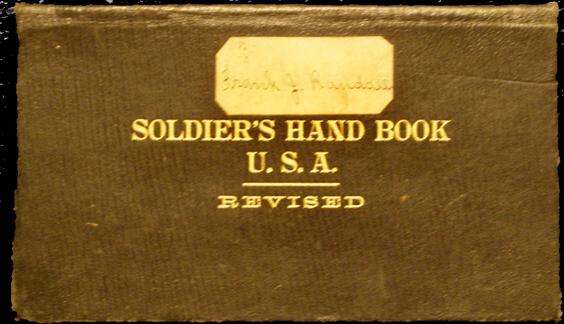
Soldier's Handbook for Private Frank J.
Randall
of Company I of the 22nd Infantry
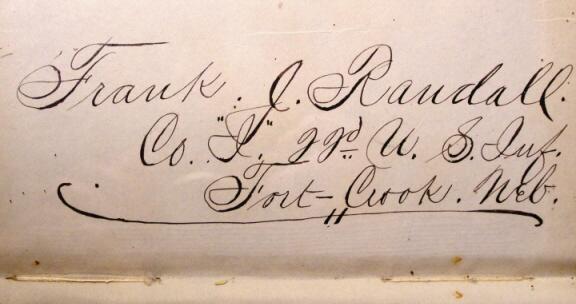
Inscribed on the first page of the Handbook is the owner's name:
Frank J. Randall
Co. "I" 22d U.S. Inf.
Fort - Crook. Neb.
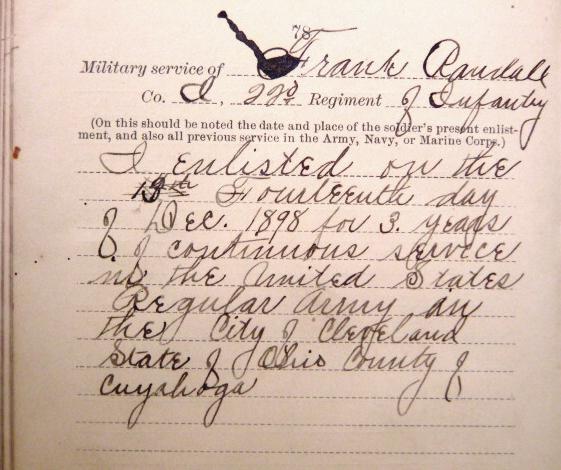
The enlistment record of PVT Randall as
noted in his Handbook
shows his enlistment beginning on December 14, 1898, and that he
enlisted in the city of Cleveland, Ohio.
After the loss of so many Soldiers of the Regiment due to disease
encountered as a result of the war in Cuba,
and end of enlistments, Randall would be one of the many newly
enlisted and untried recruits of the 22nd Infantry
sent to the grisly combat environment that was the Philippine
Islands, in March of 1899.
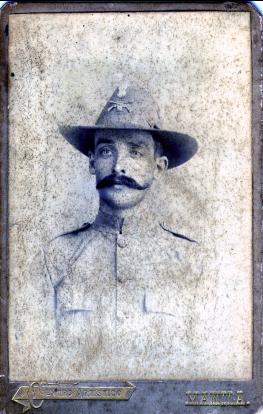
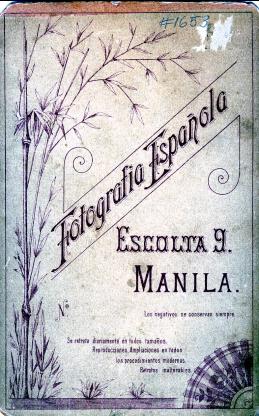
Front and back of a formal studio
portrait of a 22nd Infantry Soldier of Company M,
taken at a photographic studio in Manila, ca. 1899-1905
Webmaster's collection
The opening pages in this section from
"Arrival in the Philippines" through "The Datu Ali
Expedition" contain the official history of the 22nd
Infantry Regiment
during its service in the Philippines. The pages which present
the official history are linked together for continuity. By
clicking on the "Next Page" link at the bottom
of each page, the viewer will be taken to each successive part in
the series. Return to the HISTORY
title page for additional pages on the 22nd Infantry in the
Philippines.
Home | Photos | Battles & History | Current |
Rosters & Reports | Medal of Honor | Killed
in Action |
Personnel Locator | Commanders | Station
List | Campaigns |
Honors | Insignia & Memorabilia | 4-42
Artillery | Taps |
What's New | Editorial | Links |